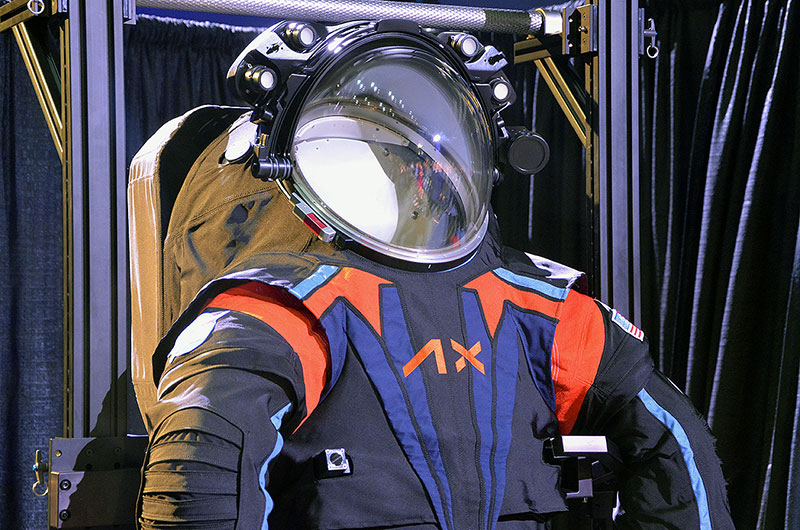17.03.2023

A new generation of spacesuit for humanity's return trip to the Moon has been unveiled by Nasa.
The novel design comes with specialist features to support astronauts as they conduct scientific experiments on the lunar surface.
The prototype is said to be a better fit for female space travellers.
Nasa hopes to have the updated suit ready for the Artemis III mission to the Moon in 2025.
he existing spacesuits worn by US space travellers have not been fully redesigned since 1981.
When Nasa announced that humanity would return to the moon after more than five decades, they promised to send the first woman and person of colour to the lunar surface.
But previous plans to send female astronauts to space have been scuppered by the lack of spacesuits in their size.
A well-fitting suit is crucial to prevent excessive fatigue and at worst, physical harm.
In 2019 Nasa had planned to send an entirely female team of astronauts to complete a space walk from the International Space Station.
But just days before Anne McClain and Christina Koch were due to depart on the walk, Nasa realised they didn't have two spacesuits in the correct size for both women, and McClain had to be replaced by colleague Nick Hague.
Nasa now believes the new design will overcome these problems and meet some of the challenges posed by the Artemis III mission to the moon, due to lift off in 2025.
The key requirement of a spacesuit is to provide oxygen at the right pressure to the astronauts which allow them to survive in the near-vacuum of space. This aspect requires careful design, as failure would see an astronaut's lungs rapidly expand causing death.
"We have a lot of tough requirements on this suit," said Lara Kearney, manager of Nasa's spacesuit and rovers team, at today's demonstration of the new design.
"The moon is a hostile place, and the south pole is really going to be a challenge. A lot of thermal requirements, we are looking for improved mobility so our astronauts can operate more efficiently."
Texas-based company Axiom Space won a $228 million (£190m) contract last year to design the suits, and now six months later they've revealed the first prototype.
In contrast to previous suits, the new Axiom Extravehicular Mobility Unit (AxEMU) spacesuit, has joints stitched in to provide the astronauts with more flexibility. It also sports inbuilt lights in the helmet.
These features are crucial as the astronauts will be required to survey geology, retrieve samples, and collect other data to further our understanding of the Moon's south polar region.
The helmet also comes with an HD video camera to allow videos from the moon to be watched in high definition back on Earth.
The new space boots should be able to withstand the freezing temperatures that are found in the permanently shadowed regions of the lunar surface.
The suits will be made using advanced manufacturing methods including 3-D printers and laser cutters to ensure exact measurements.
The prototype is part of a $1bn investment by Nasa to get two flight-ready spacesuits in time for the Moon mission.
In 2021, the space agency revealed it had already spent $420m on spacesuit development internally but was struggling to see results, so took the decision to commission the private sector to continue the work.
Mike Suffredini, Axiom Space president and CEO, said in a statement that: "Axiom Space's Artemis III spacesuit will be ready to meet the complex challenges of the lunar south pole and help grow our understanding of the moon in order to enable a long-term presence there."
The spacesuits will undergo further testing at Nasa's Johnson Space Center's Neutral Buoyancy Lab over the next year, before Artemis III launches in 2025.
NASA, Axiom reveal new spacesuits for Artemis missions to the moon
NASA and Axiom Space on Wednesday revealed the next-generation spacesuit designed to put agency astronauts — and, someday, even private customers — back on the surface of the moon.
The sleek, mostly dark gray spacesuits revealed at Space Center Houston in Texas aren't as bulky as the Apollo variants astronauts donned on the surface in the 1960s and '70s, but they serve the same purpose: protect Artemis program moonwalkers from the harsh environment of space while also providing life support, communications, tracking, and more. The design of the Axiom Extravehicular Mobility Unit, or AxEMU, was also developed in cooperation with costume designers working on the popular "For All Mankind" series available on Apple TV+.
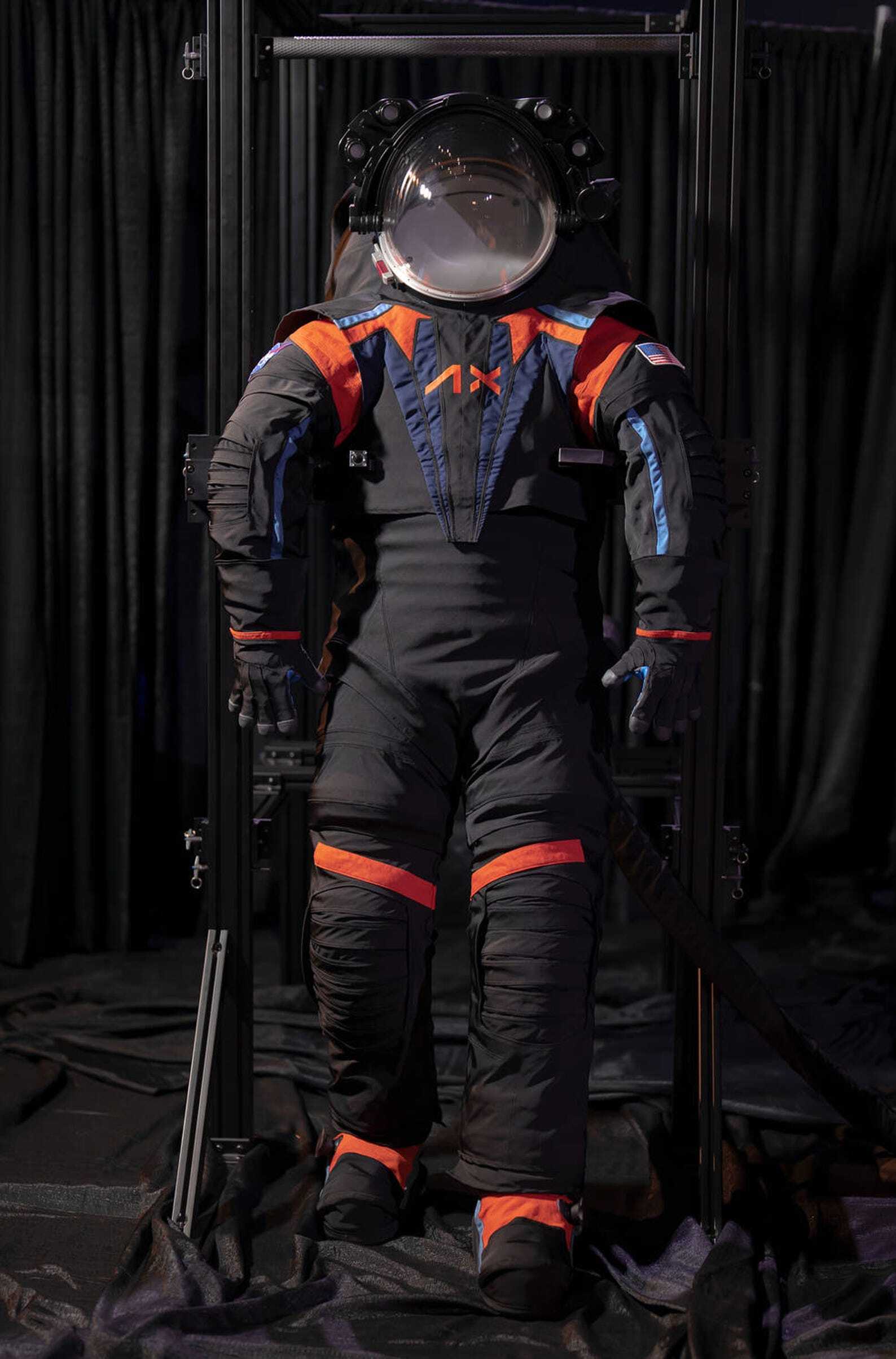
A prototype spacesuit for NASA's Artemis III mission is shown. The final version of the suit will likely be all-white, NASA said.
NASA contracted with Axiom to develop the spacesuits for the Artemis program, which aims to put two astronauts on the lunar surface sometime before 2030. The next mission to fly no earlier than late 2024, Artemis II, will send a crew of four to lunar orbit but won't include a landing. Artemis III will require the new spacesuits since that will mark the first crewed moon landing since Apollo 17 in 1972.
The final designs worn on the moon, according to NASA, will look similar to the Axiom version revealed Wednesday but will use a white material instead of the current dark-gray-and-orange version. The change in color will help keep the spacesuits cooler.
"Building on NASA’s years of research and expertise, Axiom’s next-generation spacesuits will not only enable the first woman to walk on the moon, but they will also open opportunities for more people to explore and conduct science on the moon than ever before," NASA Administrator Bill Nelson said in a statement.
The suits, according to NASA, will fit a broad range of crew and accommodate "at least 90% of the U.S. male and female population." The agency chose Axiom to develop the suits as part of its overall push to procure more hardware and services commercially rather than develop them on its own. That generally means getting services – rocket launches, spacesuits, lunar landers, and more – faster and for less money.
"Axiom spacesuits are built to provide increased flexibility, greater protection to withstand the harsh environment and specialized tools to accomplish exploration needs and expand scientific opportunities," Axiom said Wednesday. "Using innovative technologies, the new spacesuit will enable exploration of more of the lunar surface than ever before."
The partnership with Axiom also means the company, based in Houston, can use the spacesuits for its own customers. Axiom has already launched private customers on missions to the International Space Station using SpaceX's Crew Dragon capsule, so there is a very real possibility of someday putting customers on the lunar surface, too.
NASA expects the first batch of training suits to be delivered by this summer.
Quelle:Florida Today
+++
Axiom reveals prototype spacesuit for next astronauts on the moon
|
March 15, 2023
— This suit was made for walking. The Axiom-furnished spacesuits that NASA astronauts will don on the moon will have a white outer layer to reflect heat, protecting the wearer from the extreme high temperatures when in sunlight. For the purposes of Wednesday's reveal and to conceal the suit's proprietary elements, the prototype was adorned with Axiom's logo and features the company's brand colors of blue, black and orange. |
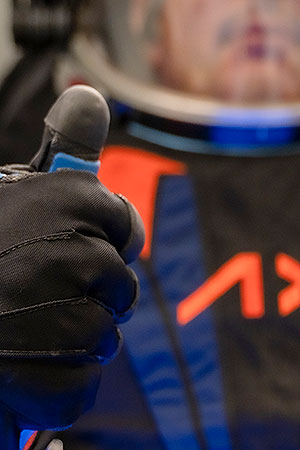 Axiom Space's prototype AxEMU spacesuit will be white when worn on the moon, but has a custom cover layer for its reveal. (Axiom)
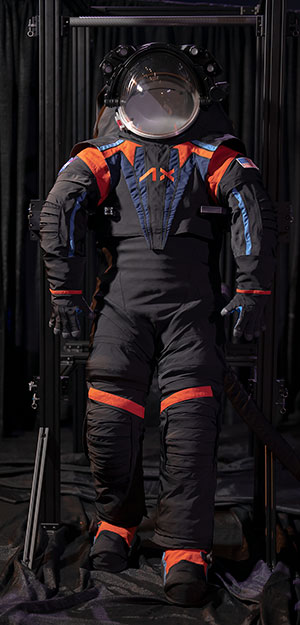 The next-generation spacesuit as designed by Axiom Space is a modular design, ready for a diverse astronaut corps. (Axiom)
|
|
Using innovative technologies, the new Axiom Space spacesuit will enable exploration of more of the lunar surface than ever before. (Axiom Space)
|
First Artemis spacesuits to be worn on the moon won't return to Earth
|
March 15, 2023
— The history-making spacesuits worn by the first woman and next American astronaut to walk on the moon will be abandoned on a SpaceX lunar lander rather than be returned to Earth for their reuse or museum display. |
 Jim Stein, chief engineer for EVA (extravehicular activity) systems at Axiom Space, models the company's prototype for the spacesuit NASA astronauts will wear on the moon during an event at Space Center Houston on Wednesday, March 15, 2023. (collectSPACE)
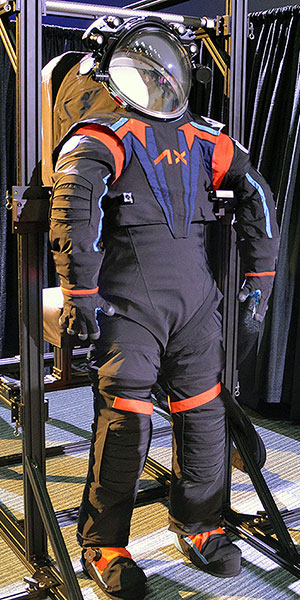 A prototype for the Axiom Extravehicular Mobility Unit (AxEMU), a spacesuit for use on the moon designed, built and being furnished to NASA by Axiom Space. (collectSPACE)
|
|
The Axiom Extravehicular Mobility Unit (AxEMU) spacesuits that will fly on NASA's Artemis III lunar landing mission in 2025 will have a white outer layer. The prototype seen here has a cover designed by Esther Marquis, costume designer for the Apple TV+ series "For All Mankind." (collectSPACE)
|
Quelle: CS



